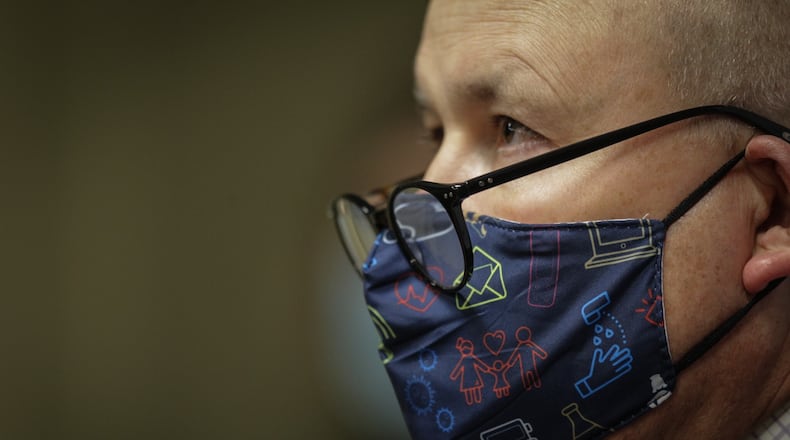Ohio broke its daily case record for the third time in a week, adding 4,961 cases as the state reported more than 4,000 cases for the third straight day. The climbing cases have been straining local contact tracers working to cut off the path of the virus, and the rise has pushed hospitals to new COVID-19 patient records in October and into November.
Dr. Steven Burdette, who has been on the front lines of the pandemic response at Miami Valley Hospital, said every so often a patient has no idea where they caught COVID-19, but the majority can name a specific time where they let their guard down and socialized in a group without masks.
“They got together to go out for drinks to watch the Ohio State game. They had eight people over for some sort of activity. They had a retirement party, and they wear masks all the time, but they didn’t at the retirement party,” Burdette said.
“Masking works. Social distancing works. Is it perfect? No, but it’s really good. And it can make a difference. But the problem is, we don’t do it enough,” Burdette said.
Burdette said he sees people every day who have moderate symptoms who are on oxygen. Most have underlying medical issues such as diabetes, high blood pressure or obesity, but they also see previously healthy people sick enough to need oxygen.
“So yes, you might be healthy. Yes, you may not have any medical problems. But you can give it to somebody who has those issues or you may be one of the small percentages of folks that gets the severe manifestation,” Burdette said, saying it is almost impossible to predict who will get the severe cases.
A small percentage of patients are the sickest of the sick who end up in the ICU. Burdette said those patients are in for longer than for influenza or normal pneumonia, sometimes for weeks and weeks.
“I’ve been doing this 15 years. I spend a lot of my time in the intensive care unit taking care of infections. We’re used to those infections. The things that we see with COVID is very different,” he said.
There aren’t miracle cures for the disease. Steroids are just for people sick enough to need oxygen support. The hospital gives some patients the antiviral remdesivir but patients don’t always improve.
“It’s expensive. We still give it and I’m not sure that it’s not the end all — it does not kick in and all of a sudden makes you better … We see people every day who get the entire course of remdesivir and it didn’t change their oxygen requirements at all,” Burdette said.
Health officials at both state and local press conferences Thursday urged Ohioans to get back to the basics to slow the spread.
“Game day watch parties, large wedding receptions, house parties, extended family gatherings, all of those social settings are why this virus is spreading,” Jeff Cooper, Public Health - Dayton & Montgomery County, said.
At DeWine’s afternoon press conference, the governor pushed back against claims that the state’s increase in cases was due to increased testing, noting that cases have increased at a higher rate than testing has.
Since Sept. 24, Ohio has increased the total number of tests by 44%, he said. In that same period, cases increased by 280%.
All Ohio counties for the first time meet the CDC definition for “high incidence” of coronavirus spread.
There are 56 red, or level 3, counties in Ohio, the most the state has ever reported and an increase of 13 counties from last week.
Butler, Champaign, Clark, Greene, Montgomery, Preble and Warren counties are all red. Miami, Darke and Logan counties are orange.
Of the 56 red counties, seven had never been red before, including Champaign County.
DeWine announced new members to the Ohio Department of Health Thursday, including naming Stephanie McCloud as the state’s new health director.
“This is the most dangerous stage we’ve been at,” he said. “I need a person that can focus on administration, making things run, getting a vaccine out. In Stephanie McCloud I have someone I have a great deal of confidence in. She will do what needs to be done every day.”
McCloud previously was appointed as director of the Ohio Bureau of Workers Compensation by DeWine.
“She has the experience necessary to lead the Ohio Department of Health as it carries out its important health functions while also battling the pandemic,” he said.
The governor also named Dr. Bruce Vanderhoff as chief medical officer of the ODH.
Vanderhoff has worked as the senior vice president and chief medical officer of OhioHealth for more than a decade.

